Network Connections Folder will be empty if your computer is unable to detect network drives. This issue is not new, not just Windows 11 or Windows 10 users, but even Windows 8/7 users reported that the folder is empty and sometimes, Network Adapters are missing. In this post, we will see what you can do if Network Connection Folder is empty.
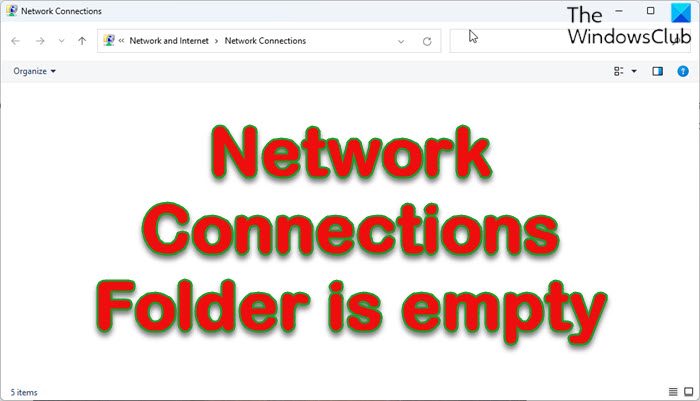
Why is my Network Connections folder empty on Windows?
If the system is unable to communicate with the network adapter and/or the network adapter is unable to communicate with the connected network, no content (including files and folders) will be present inside the Network Connections folder. The lack of communication is usually due to misconfigured network settings and everything related to it such as a registry. However, we have also encountered this issue after updating the network driver, in that case, the best solution is to use System Restore. To get more info and to find all the potential solutions, go to the troubleshooting guide mentioned hereinafter.
Network Connections Folder is empty in Windows 11/10
There are many reasons for this problem; one of the reasons is that Windows Update failed to install or update the Network drivers, in that case, you have to update the required driver manually. However, there are various other reasons and solutions that we are going to explore. So, if the Network Connections Folder is empty on your computer, follow the sol
- Restore your PC to its previous version via System Restore
- Run Network Troubleshooter
- Disable VPN
- Troubleshoot in Clean Boot
- Clear the configuration cache
- Update Network Driver
- Edit ClassManagers
- Reset the Network Setting
Let’s get started.
1] Restore your PC to its previous version via System Restore
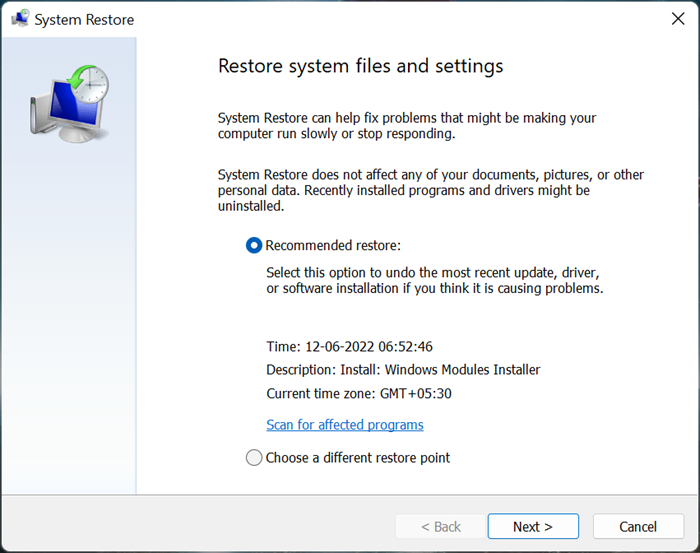
A lot of users reported that when the network adapter was updated, they found the Network Connections folder was empty. However, we can fix the problem caused by the update using a System Restore feature because doing so restores Windows back to its earlier state. The personal files are not altered by System Restore, although it may uninstall newly installed software and drivers from the computer. That is why create a backup before proceeding with this solution.
Here is how to use the restore point.
- Press Windows + R key to open the run dialog box.
- Type rstrui in the run box and press enter button.
- Select Recommended Restore or any other restore point and click Next
Follow the on-screen instructions to restore your computer to earlier. After updating the system, check if the issue is resolved.
Related: This network connection does not exist
2] Run Network Troubleshooter
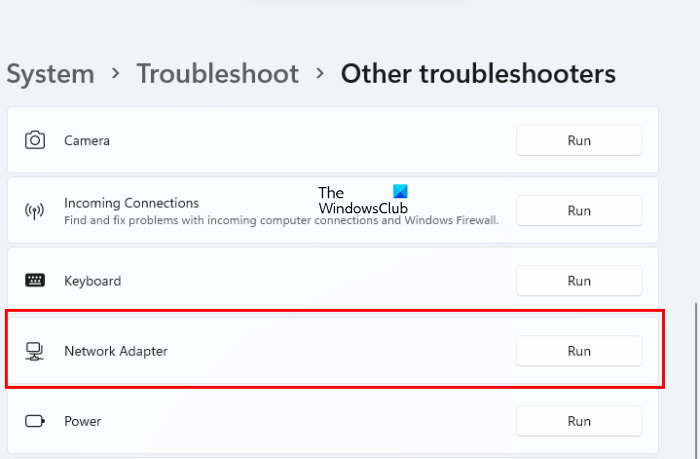
Microsoft Windows 11 provides a built-in Windows Troubleshooter that includes a set of troubleshooting tools to help us automatically find and fix problems with wireless and other network adapters. Let us learn to solve the Network connections folder is the empty problem by using a Network troubleshooter.
Here’s how to run Network troubleshooters
- Press Windows Key then type “troubleshooting settings” in the search menu and press Enter.
- Click Other troubleshooters.
- Scroll down the screen and find the Network Adapter option and click the Run button next to it.
- The network adapter troubleshooter will run immediately to find and fix possible problems with network adapters.
- After completing the troubleshooting process, click Next to view the output message.
Hopefully, running a network troubleshooter will resolve your issue.
3] Disable VPN
If you are connected to a VPN, it is very likely that your computer is unable to connect to the network and the Network Connection folder is empty. So, if you are connected to a VPN, just disable it and check if the issue is resolved. For example, Checkpoint Secureclient VPN is known to have caused this issue; disabling or uninstalling it will solve the issue.
4] Troubleshoot in Clean Boot
VPNs are the only apps capable of triggering network issues. To find that out, we need to perform Clean Boot to boot your computer without any interfering app. After booting the system, connect to the network and then find out if the network connection folder is still empty. If the folder is not empty, manually enable processes to find out what causes the issue. Once you know the culprit, just uninstall it and your issue will be resolved.
5] Clear the configuration cache
Some Windows users stated that when they updated the network card driver, they face a situation where the Network Connections folder is not showing any network adapters, however, the Internet is working fine. In our computer’s registry, Windows keeps a cache of network adapter configurations and if this cache gets corrupted, such problems will arise. In such cases, clearing the cache will resolve the issue, so follow the steps prescribed below to do the same:
- Press Windows + R key to open the run dialog box.
- Type regedit in the run dialog box to open the registry.
- Once the Registry Editor screen opens, go to the following location:
HKEY_LOCAL_MACHINE\SYSTEM\CurrentControlSet\Control\Network
- Finally, in order to clean the configuration, delete the Config file.
Close the Registry Editor screen, restart your computer, and now when you reopen the Network Connections folder, you will find that your issue is resolved
6] Update Network Driver
Sometimes, during Windows Update, the OS fails to install or update the network drivers, due to which we see the Network connections folder is empty. However, we can pretty easily search for Network Driver updates and install the latest files in Device Manager. So, go ahead and update the driver using the following steps.
- Press Windows + R key to the open Run dialog box.
- Type devmgmt.msc and press Enter button.
- Expand the Network adapters here.
- Right-click on the network driver and select Update driver.
- Select Search automatically for drivers.
- Finally, follow the on-screen instructions to complete the update.
You can also update the driver from the manufacturer’s website or use free driver update software. After updating drivers, check if the issue is resolved.
Read: How to install WiFi drivers for Windows
7] Edit ClassManagers
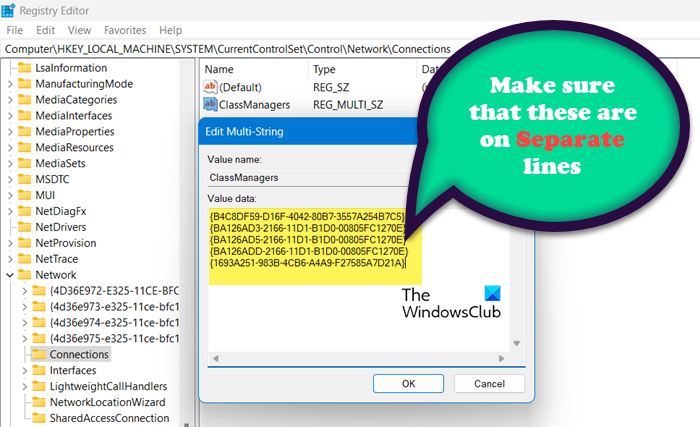
There is a Multi-String key called ClassManagers which holds some GUID strings. All the strings that it holds should be on separate lines, but, if the Network Connection folder is empty, check if these strings are somehow in the same line.
To do the same, open Registry Editor from the Start Menu and then go to the following location.
HKEY_LOCAL_MACHINE\SYSTEM\CurrentControlSet\Control\Network\Connections
Open ClassManager and make sure that strings in curly braces have their separate lines. Check out the image given here to have a clear understanding. After making the changes, reboot your computer and check if the issue is resolved.
8] Reset Network settings
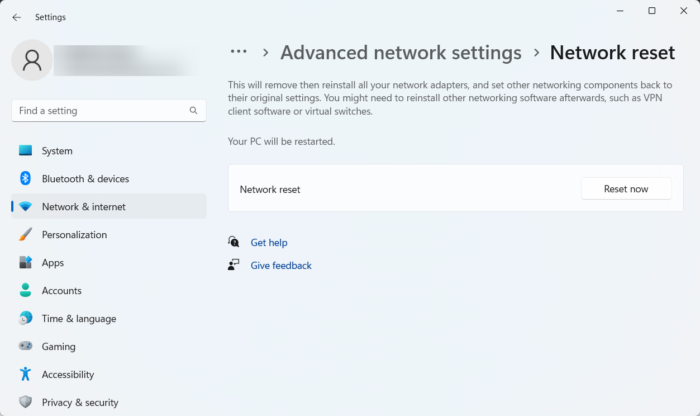
If you have already used the above methods and the problem is not solved yet then try to reset the network setting. If the issue is a result of misconfigured network settings, this solution will do the trick for you. Follow the prescribed steps to reset the network settings.
- Press Windows + I key to open the Setting app.
- Click on Network & Internet.
- Now, click on Advance network settings.
- Click on Network reset and select Reset now.
After resetting, the network settings, check if the issue is resolved.
You may face similar issues when your network adapter is missing. Since it is a network issue, you can execute the solutions mentioned in this post, but if you need a detailed guide, check our post on what to do when Network adapters are missing on a Windows 11 computer.
Hopefully, you are able to resolve the issue using the solutions mentioned in this article.
Also read: Microsoft Hosted Network Virtual Adapter missing in Device Manager.
Leave a Reply